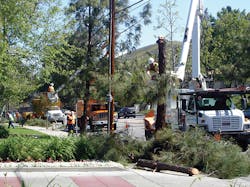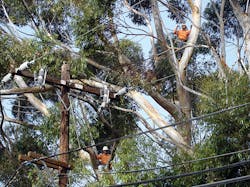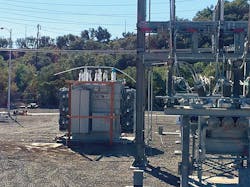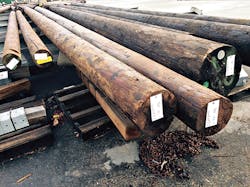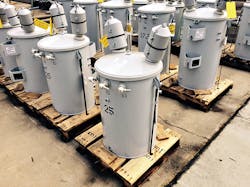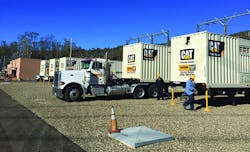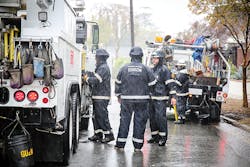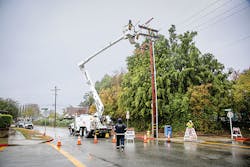With the El Niño storms on the horizon, Southern California Edison (SCE) is taking a proactive, rather than a reactive, approach to storm planning and logistics. Before the rain drenches the West Coast, field crews are inspecting infrastructure, vegetation management crews are clearing trees near lines, and the utility is staging replacement equipment and portable generators.
In addition, the utility is also training linemen and educating customers so when the next round of storms hits, they know not only what to expect, but how to handle any situation that arises quickly and easily. To ensure SCE has as much information as possible, its in-house meteorologists are monitoring storms and severe weather activity.
Rather than being a single storm, El Niño is a weather system dealing with atmospheric conditions, wind currents and unusual weather patterns. According to scientists and meteorologists, California has been in an El Niño period since March 2015.
The last significant El Niño storms wrecked havoc in 1997 and 1998. The storms inflicted damage to SCE’s main artery feeding Santa Barbara, which includes 40 miles of 220-kV transmission lines that transport power to Carpinteria, Santa Barbara and Goleta, California, and serve 80,000 customers.
Two of the 220-kV towers also shifted slightly from the landslide. While they didn’t topple over or cause any wire to fall down, the linemen did need to conduct repairs and install temporary towers during the rainy season. The flooding, flow of debris and mudslides also inflicted damage to the utility’s distribution system and to nearby homes and roads. To restore power, field crews made repairs to those customers who were out of power.
Protecting Assets
While heavy rains are unusual in Southern California in the wintertime, the region had twice as much rainfall as normal in the winter of 1997-98. The utility wasn’t as concerned with the total volume but the rate of rainfall. Because the soil in this region is not designed to fully absorb a high level of rainfall, it can cause significant challenges for the utility, namely flooding.
Some of the large ravines collect the heavy rainfall, but damage can occur to the SCE substations at the base of the foothills. In these locations, the volume of water is exponentially greater. The utility identified the Santa Barbara/Carpinteria area as the area of greatest concern because any flooding in the substation can have a significant impact.
To prevent future damage, SCE has installed strategically placed, customized K-rails around the substation to block potential debris flow from the foothills. In other areas, the utility has placed sandbags, and it has also shored up retainer walls along its transmission corridors and installed polyurethane sheeting to prevent erosion. Also, the linemen have tied some of the footings together to strengthen the rigidity of the towers without changing their integrity. With this approach, the footings can help to support one another.
Along its waterways and patrol roads, SCE has built berms to deflect the flow of water. In addition, the utility has conducted significant patrols across all of its transmission lines that are most at risk of erosion, such as those areas that are historically most at risk of landslides. At a minimum, the utility has conducted foot and helicopter patrols to identify any signs of erosion or any need for further reinforcement.
Creating Teams
At the end of 2015, it became clear the El Niño event would manifest and deliver significant rain storms. As such, SCE developed a plan that reinforced its current inspection and maintenance repair construction activity to better prepare for what was around the corner.
To take immediate action, SCE created weather preparation strike teams. One group zoned in on the Santa Barbara and Goleta areas while another focused on the other parts of the service territory. These individuals determined whether SCE had enough redundancy in its system to withstand a few thousand disturbances over the period of a few days. To this end, the transmission, distribution and substation divisions could take practice steps to ensure that they were prepared.
Meanwhile, SCE created a third group focused on communication, strategy and engagement with local, county, state and federal stakeholders. As a result, SCE is hoping to build awareness, secure support and foster collaboration throughout the entire period during the El Niño event. This team has been in motion for several months, and during that time, it has conducted a hazard assessment, implemented a plan to mitigate issues in the northern part of its service territory, and launched a series of inspections and patrols of targeted transmission and distribution lines and substations. In addition, SCE has evaluated vegetation management activity across the same vulnerable corridors.
The utility targeted a completion date of January 2016 for these activities. In addition to going above and beyond its regular inspection cycle, the teams are identifying any other areas of potential concerns, making repairs that can’t be postponed and reinforcing the system. In addition, the field workforce is helping to ensure any abnormalities have been addressed such as problems with sump pumps in substations.
Taking Other Proactive Steps
Along with performing inspections, SCE has built up its inventory of critical spare equipment and parts such as transformers, switches, batteries and chargers. In addition, the utility has set up a mobile command center and set up an incident command system.
Through this initiative, the utility has trained nearly 800 employees and identified a roster of 18 individuals to act as incident commanders, safety officers and planning section chiefs. With this program, SCE has been able to provide more structure on how it responds to storms.
Over the last few years, the utility has experienced severe storms, but by following the protocols outlined by the ICS, the crews are able to better prepare for and execute their storm response strategy. To this end, the company has partnered with the Office of Emergency Services to be able to plan ahead if it is deploying an incident command team. As such, it notifies the office of where its crews will be stationed and whom else it will be working with and, in turn, keeps the cities and counties in the communication loop. Also, SCE has reviewed its mutual assistance strategy and kept in touch with its neighboring utilities to the north and the south so it can secure additional resources if necessary.
SCE has also taken some steps to mitigate future tower displacement in other rainstorms. For example, the linemen are working toward upgrading the capacity of the lines feeding into Santa Barbara and rerouting some sections of lines that were traversing more vulnerable areas. In fact, crews have built several retainer walls, and as a result, they didn’t experience as much damage to their system during the rain storms.
The lessons it learned from past storms also shaped SCE’s approach to future El Niño events. For example, the utility is deploying about 60 MW of mobile generators in targeted substations in the Santa Barbara area. That way, if it loses the main artery feeding into Santa Barbara again, it can keep the power on. To ensure this power backup is up and operational, SCE has successfully tested the synchronization of the power lines and peaker plants in the area with the interconnection into the substations.
Preparing Crews and Customers
Another part of SCE’s proactive plan is to prepare both its linemen and customers to respond to a future El Niño storm. For example, during the first quarter of last year, the utility focused on building awareness internally and externally. That way, it could prepare its crews with the mindset of how to operate within a very wet season with heavy and violent rains. SCE wanted to ensure the crews were prepared both at home, in the office and in the field to work in these conditions. For example, the utility inspected a lot of the personal protective equipment and gear to ensure it had the right type of gear for its rainy season.
In addition, the utility provided refresher training to its field crews who may have not been familiar with how to operate within a rainy season. While heat, fire and high winds are common in Southern California, heavy rain is relatively rare in non-El Niño seasons. For example, the linemen are learning how to operate and switch equipment in wet conditions. In addition, they are learning what precautions to take in their substations and distribution lines, as well as what troubleshooting they can do in rainy environments and what kind of work should be deferred for drier weather. While this is part of their training, SCE emphasized key points and safety practices to prepare them for future El Niño events.
Finally, SCE is also focusing on making its customers aware of what may come as result of the storm. Through its website, regular publications and bill inserts, the utility is spreading the message about the impending severe weather events. That way, the customers will know what to look out for during stormy conditions and how to prepare for outages at home. In addition, SCE is working with its local customers directly as well as the local community, government and key stakeholders to invite them to take advantage of these resources, as well.
With these proactive strategies, the level of preparation is unprecedented. But if SCE experiences a significant storm event, it hopes to be as ready as it can be to spring into action and swiftly restore power.
Paul Grigaux, vice president of transmission, substations and operations for Southern California Edison, contributed to this story. He is a mechanical engineer and has served in the industry for the past 20 years. Prior to working for SCE, he worked for an equipment and service provider and a non-regulated utility.
Editor’s note: To view video footage, visit http://newsroom.edison.com/gallery/file?fid=568c2ec15e8eef5d114deb9d.
To learn how the utility is preparing its customers for El Niño, visit http://insideedison.com/getting-ready-for-el-nino-storms.
About the Author
Amy Fischbach
Electric Utilities Operations
Amy Fischbach is the Field Editor for T&D World magazine and manages the Electric Utility Operations section. She is the host of the Line Life Podcast, which celebrates the grit, courage and inspirational teamwork of the line trade. She also works on the annual Lineworker Supplement and the Vegetation Management Supplement as well as the Lineman Life and Lineman's Rodeo News enewsletters. Amy also covers events such as the Trees & Utilities conference and the International Lineman's Rodeo. She is the past president of the ASBPE Educational Foundation and ASBPE and earned her bachelor's and master's degrees in journalism from Kansas State University. She can be reached at [email protected].


